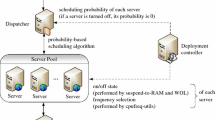Abstract
Application server cluster (cluster for short) is generally designed to handle peak load, resulting in an excessive waste of energy; hence, its deployment should be dynamically adjusted according to changing load. In this paper, we propose a power-aware dynamic deployment scheme for application server cluster, which aims to minimize cluster’s power consumption under given target of CPU utilization guarantee. Firstly, we present an approach to guarantee server’s CPU utilization equal to a given target value through load allocation and Dynamic Frequency Scaling (DFS), deduce the power models of Discrete DFS (D-DFS) and Equivalent Continuous DFS (EC-DFS) manner, and analyze the power and continuity advantages of EC-DFS. Then, combining DFS, server Dynamic Switching On/Off and probability-based request scheduling, we transform cluster’s power-aware dynamic deployment problem to a programming problem, whose variable number is less than other similar researches. Finally, an efficient Differential Evolution-based solving algorithm is proposed to solve the problem. Test results verify the advantages of EC-DFS, and demonstrate the effectiveness of our deployment scheme and solving algorithm.






Similar content being viewed by others
References
Al-Hazemi, F., Kang, D. K., Kim, S. H., Peng, Y., Newaz, S. H. S., & Youn, C. H. (2016). LPCFreqSchd: a local power controller using the frequency scheduling approach for virtualized servers. Cluster Computing, 19(2), 663–678.
Bilal, K., Fayyaz, A., Khan, S. U., & Usman, S. (2015). Power-aware resource allocation in computer clusters using dynamic threshold voltage scaling and dynamic voltage scaling: comparison and analysis. Cluster Computing, 18(2), 865–888.
Barroso, L. A., & Hölzle, U. (2007). The case for energy-proportional computing. Computer, 40(12), 33–37.
Shi, X., Dong, J., Djouadi, S. M., Feng, Y., Ma, X., & Wang, Y. (2016). PAPMSC: power-aware performance management approach for virtualized web servers via stochastic control. Journal of Grid Computing, 14(1), 171–191.
Raj, M., Kumar, V., & Raghunathan, S. (2016). Power management using dynamic power state transitions and dynamic voltage frequency scaling controls in virtualized server clusters. Turkish Journal of Electrical Engineering and Computer Sciences, 24(4), 2290–2306.
Al-Qawasmeh, A. M., Pasricha, S., Maciejewski, A. A., & Siegel, H. J. (2015). Power and thermal-aware workload allocation in heterogeneous data centers. IEEE Transactions on Computers, 64(2), 477–491.
Mazumdar, S., & Pranzo, M. (2017). Power efficient server consolidation for cloud data center. Future Generation Computer Systems, 70, 4–16.
Bertini, L., Leite, J. C. B., & Mossé, D. (2010). Power optimization for dynamic configuration in heterogeneous web server clusters. Journal of Systems and Software, 83(4), 585–598.
Gao, Y., Guan, H., Qi, Z., Song, T., Huan, F., & Liu, L. (2014). Service level agreement based energy-efficient resource management in cloud data centers. Computers & Electrical Engineering, 40(5), 1621–1633.
Deng, Y., Hu, Y., Meng, X., Zhu, Y., Zhang, Z., & Han, J. (2014). Predictively booting nodes to minimize performance degradation of a power-aware web cluster. Cluster Computing, 17(4), 1309–1322.
Case, S., Afram, F., Aktas, E., & Ghose, K. (2012). Energy-aware load direction for servers: A feasibility study. In Proceedings of 2012 20th euromicro international conference on parallel, distributed and network-based processing, pp. 359–367.
Enokido, T., Duolikun, D., & Takizawa, M. (2017). An energy-aware load balancing algorithm to perform computation type application processes in a cluster of servers. International Journal of Web and Grid Services, 13(2), 145–169.
Sousa, L. S., Leite, J. C. B., & Loques, O. (2013). Green data centers: Using hierarchies for scalable energy efficiency in large web clusters. Information Processing Letters, 113(14–16), 507–515.
Valentini, G. L., Lassonde, W., Khan, S. U., Min-Allah, N., Madani, S. A., Li, J., et al. (2013). An overview of energy efficiency techniques in cluster computing systems. Cluster Computing, 16(1), 3–15.
Chandnani, L., & Kapoor, H. K. (2013). Formal approach for DVS-based power management for multiple server system in presence of server failure and repair. IEEE Transactions on Industrial Informatics, 9(1), 502–513.
Li, K. (2012). Optimal configuration of a multicore server processor for managing the power and performance tradeoff. Journal of Supercomputing, 61(1), 189–214.
Gandhi, A., Harchol-Balter, M., Das, R., Kephart, J. O., & Lefurgy, C. (2009). Power capping via forced idleness. In Proceedings of workshop on energy-efficient design.
Brodowski, D. Linux CPUFreq. https://www.kernel.org/doc/Documentation/cpu-freq/index.txt.
ArchWiki, Power management/Suspend and hibernate. https://wiki.archlinux.org/index.php/Power_management/Suspend_and_hibernate.
ArchWiki, Wake-on-LAN. https://wiki.archlinux.org/index.php/Wake-on-LAN.
Liu, J., Teo, K. L., Wang, X., & Wu, C. (2016). An exact penalty function-based differential search algorithm for constrained global optimization. Soft Computing, 20(4), 1305–1313.
Ali, M. M., & Zhu, W. X. (2013). A penalty function-based differential evolution algorithm for constrained global optimization. Computational Optimization and Applications, 54(3), 707–739.
Gao, L., Zhou, Y., Li, X., Pan, Q., & Yi, W. (2015). Multi-objective optimization based reverse strategy with differential evolution algorithm for constrained optimization problems. Expert Systems with Applications, 42(14), 5976–5987.
OW2 Consortium, RUBiS. http://rubis.ow2.org/.
ACME Laboratories, Http_Load - Multiprocessing Http Test Client. http://www.acme.com/software/http_load/.
The OpenMP ARB, OpenMP. http://openmp.org/.
Acknowledgements
This work is supported by the National Natural Science Foundation of China (No. 61202366), the Special Funds for Discipline and Specialty Construction of Guangdong Higher Education Institutions (No. 2016KTSCX040), and the Science and Technology Planning Project of Guangdong Province (Nos. 2016B090920095 and 2016B010124012).
Author information
Authors and Affiliations
Corresponding author
Rights and permissions
About this article
Cite this article
Xiong, Z., Zhang, Q., Cai, L. et al. Power-Aware Dynamic Deployment Under CPU Utilization Guarantee for Application Server Cluster. Wireless Pers Commun 102, 1485–1502 (2018). https://doi.org/10.1007/s11277-017-5207-y
Published:
Issue Date:
DOI: https://doi.org/10.1007/s11277-017-5207-y




